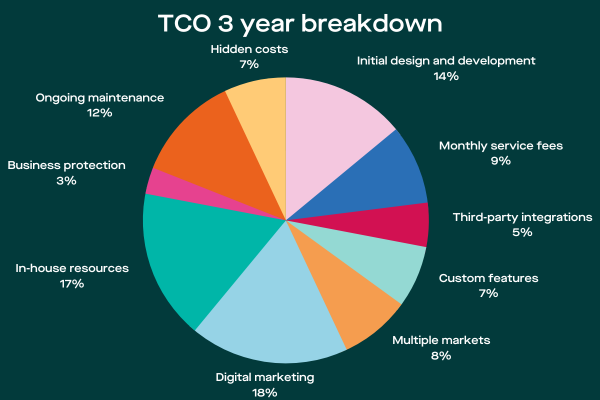eCommerce TCO 10-point checklist
Is your online store delivering great return on investment? The first step in optimising your ROI is to accurately map your total cost of ownership (TCO), which means identifying all the direct and indirect expenses associated with implementing, managing, and maintaining your eCommerce solution over its lifetime. a clear breakdown of these costs can help you allocate resources strategically and effectively.
For small to medium-sized businesses, the average investment in eCommerce over a three-year period ranges from £30,000 to £300,000 – a poorly optimised platform can make or break productivity and impact growth and profit.

Key areas of investment
Let’s explore the Top 10 areas you need to include in your TCO planning, and how much typically you should expect to invest in each area:
Over a 3-year period (both Capex and ongoing costs)
1. Initial design and development – 14%Although costs will vary greatly depending on the complexity of your store and the type of platform you choose, it’s likely that the initial design and development costs will account for a significant percentage of your overall eCommerce spend. Investing in a user-friendly and visually appealing website is essential to create a positive first impression for potential customers.
2. Monthly service fees – 9%
In addition to initial setup fees, tot up all ongoing charges from your eCommerce provider for the lifetime of your online store, including hosting fees, software licensing costs, and technical support charges. These fees are essential ongoing for the smooth running of your online store.
3. Third-party integrations – 5%
Include costs for vital integrations, which can include payment gateway functionality as well as stock management, CRM, email services, customer reviews, and courier systems. Third party integrations are often an important part of enhancing the customer experience.
4. Custom features – 7%
While the cost of your store’s standard functionality should be covered as part of its initial design and build, more complex features are likely to incur additional charges, particularly any bespoke developments.
5. Multiple markets – 8%
Factor in integration costs and third-party charges for selling via multichannel marketplaces such as eBay and Amazon, as well as design and development fees for additional B2B, B2C or international storefronts with localised content and payment options.
6. Digital marketing – 18%
On top of agency contract charges, make sure your TCO calculation includes marketing-related costs such as advertising budgets, influencer fees, marketing functionality updates, and sales commission.
7. In-house resources – 17%
Factor in how much you spend on salaries and benefits for staff responsible for the day-to-day operations of your online store. This cost can vary depending on your solution and serve as a benchmark if you're considering a new eCommerce provider.
8. Business protection – 3%
Firewalls, data encryption, antivirus software, and specialist eCommerce insurance are all essential requirements to build into your total cost, along with any development work or legal advice needed to keep on top of changing eCommerce legislation.
9. Ongoing maintenance – 12%Identify and include costs for minor adjustments, cosmetic updates, revised functionality fees, ongoing site optimization, peak trading preparation, and bug fixes throughout the lifetime of your online store.
10. Hidden costs – 7%Less obvious costs such as transaction charges and user onboarding fees differ greatly between eCommerce providers, but they can soon mount up, so it’s a worthwhile exercise to identify hidden costs to make sure you’re getting a good deal.
Remember that the percentages provided here are approximate and can vary based on the unique requirements and objectives of each business. By carefully evaluating the TCO and making informed decisions, businesses can position themselves for success in the highly competitive eCommerce landscape.
Next Steps:
Your mileage may vary, your business is unique – with its own challenges and opportunities.
Speak to an eCommerce Specialist today or download our eCommerce TCO guide .